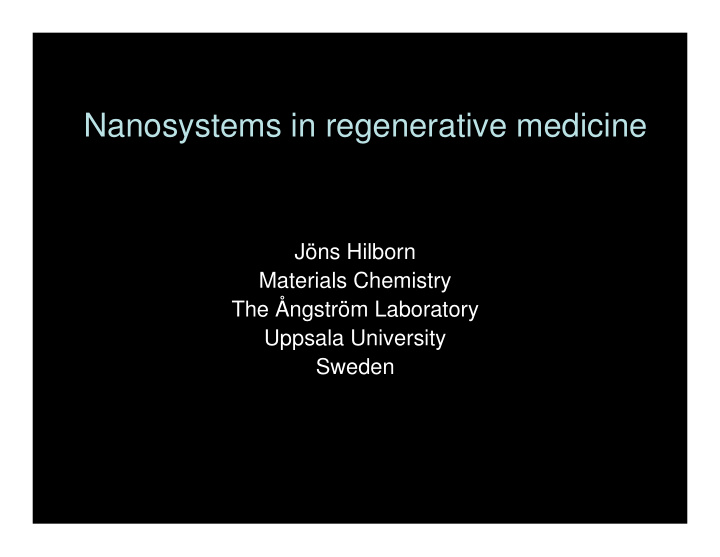



Nanosystems in regenerative medicine Jöns Hilborn Materials Chemistry The Ångström Laboratory Uppsala University Sweden
Outline • Motivation for tissue regeneration • Cell based approaches • Material based approaches
Drug Biologic Device • Drug (21 USC 201(g)) - Articles intended for use in the diagnosis, cure, mitigation, treatment, or prevention of disease in man or other animals; and…to affect the structure or any function of the body of man or other animals • Biologic (42 USC 351(i)) - Virus, Therapeutic Serum, Toxin or Antitoxin, Vaccine, Blood, Blood Component or Derivative, Allergenic Product , Protein (except any chemically synthesized polypeptide), or Analogous Product, … applicable to the prevention, treatment, or cure of a disease or condition of human beings • Device (21 USC 201(h)) - An instrument, apparatus, implement, machine, contrivance, implant, in vitro reagent, or other similar or related article which is intended for use in the diagnosis, cure, mitigation, treatment, or prevention of disease; or… to affect the structure or any function of the body of man or other animals; And does not achieve its primary intended purposes through chemical action within or on the body of man and is not dependent on being metabolized to achieve its primary intended purposes
Pharma's Developing Interest in Stem Cells Cell Stem Cell, Volume 6, Issue 6, 4 June 2010, Pages 517-520
The three components Cells Matrix Growth factors Challenges: Scar formation & vascularization
Traditional approach Harvest – isolate – expand – differentiate – seed on scaffold - implant
Stem Cells • hEMCs (derived from blastocysts) • Haematopoetic progenitors / stem cells (HSCs) • Mesenchymal/stromal stem cells (MSCs) • Tissue specific progenitors (tissue turnover and renewal)
Implanted cells without nutrient supply die
1. Bone formation by collagen and BMP-2 (mg) Bone formation by BMP-2 • Collagen/heparin
Bone fabricated from a muscle BMP 2 Blood vessel Mould Bone
MiraGel™ shortens healing time and regenerates tissue TIME
Stem Cell Quality • Complex mixture • Should be well defined & characterized • ESC and iPS should be lineage comitted (teratoma)
From harvest to use • Origin, sampling procedure – markers • Reprogramming (iPS) • Expansion supporting undifferentaited cells • In vitro differentiation • Select intended biologically active population
Characterization • Identity • Purity • Potency • Tumourigenicity
Non-clinical • Animal models • Biodistribution niche • Tomourigenicity and genomic stability • Differentiation in vivo • Immune rejection & persistence
Clinical considerations • Pharmacodynamics • Pharmacokinetics • Dose finding studies • Clinical efficacy • Clinical safety
Orthodontics & Craniofacial Mastrogiacomo, A Muraglia, V Komlev, ResearchVolume 8, Issue 4, pages 277– F Peyrin, F Rustichelli, A Crovace, R 284, November 2005 Cancedda
Homing of stem cells
Hyaluronan is a safe biopolymer • Identical in all vertebrates • Water soluble with short in-vivo life time • Long tested biocompatibility • Can be derived from animals or produced in culture • Biologically active • Contains functional groups allowing modification
Borrowed from Nature
Hyaluronan Polyvinylalcohol -NHNH 2 -CHO PBS, 37C Medical device Functionalized turns it into a drug
Cross-linking in situ Gel formation < 1 min
Gel formation in 30-40 seconds
The matrix shows complete degradation, no inflammation and efficient bone formation in the rat model Gel 4 weeks Gel + 50 µ g BMP2 4 weeks
Analysis of cytotoxicity
Active growth factor release Fig 5. Release profile of active rhBMP-2 from cross-linked hydrogels up to 28 days of incubation in vitro . ALP activity of cells cultured in presence of cross-linked hydrogels were immersed for different time points up to 28 days revealed a continuous and prolonged active rhBMP-2 release.
Bone grafts • 2.2 million grafts per year • 2.5 billion USD cost • Major problem is donor site morbidity • Costs: Open surgery, hospitalization
Cranial repair in the pig model
Clinical trials 1. Repair of alveolar clefts 2. Craniotomy
FIGURE 2 5 mm
Sub periostal tunneling Aim: To replace open surgery by injection Model: a b Rat (na=26)
FIGURE 6 Sham No rhBMP-2 [5 µg/mL] rhBMP-2 [150 µg/mL] rhBMP-2 Fig 8. Representative 3D reconstruction images from miro Computed Tomography (µCT) of hemimandibles of each experimental group after 8 weeks. (a) sham injected hemimandible (b) Superiosteal injection of hydrogel + HAp without rhBMP-2. (c) Subperiosteal injection of hydrogel + HAp+ [5 µg/mL] rhBMP-2 (d) Subperiosteal injection of hydrogel + HAp+ [150 µg/mL] rhBMP-2. Scale bars: 1 mm
Successfully augmented bone is firmly linked to existing bone C C 2.5 x 2.5 x D 2.5 x 2.5 x D E 20 x F 10 x 10 x E 20 x F
Future product for Arthritis • US expentitures for arthritis 2005 was $353 billion USD • 19 million people affected in US alone • 40% expected growth in number of patients until 2030
Regenerates healthy cartilage to potentially treat arthritis Rabbit model: Collagen type II shows healthy cartilage while collagen type I is a sign of fibrotic cartilage
Product definitions Combination Product (21 CFR 3.2 (e)(1)) - A product composed of two or more components which would normally be regulated under different regulatory authorities (e.g., biologic + device, biologic + drug) that are physically, chemically, or otherwise combined or mixed and produced as a single entity Human Cells, Tissues, and Cellular and Tissue Based Products (HCT/Ps) 21 CFR 1271.3 d): Articles containing or consisting of human cells or tissues that are intended for implantation, transplantation,
Evolution of Stem Cell field Evolution of Stem Cell Field: � Cell therapy and gene therapy products –and therefore stem cell products-- do not lend themselves to a “one size fits all” concept of product development and regulation. � Regulations set framework of criteria that must be fulfilled: safety, identity, purity, potency, and clinical efficacy � Flexibility in how to fulfill the criteria
Summary • Tissue Engineering & Regenerative Medicine holds enormous potential • Safety & Efficacy are key issues for both cell based and material based approaches • We will see new approaches using other stimuli
Recommend
More recommend